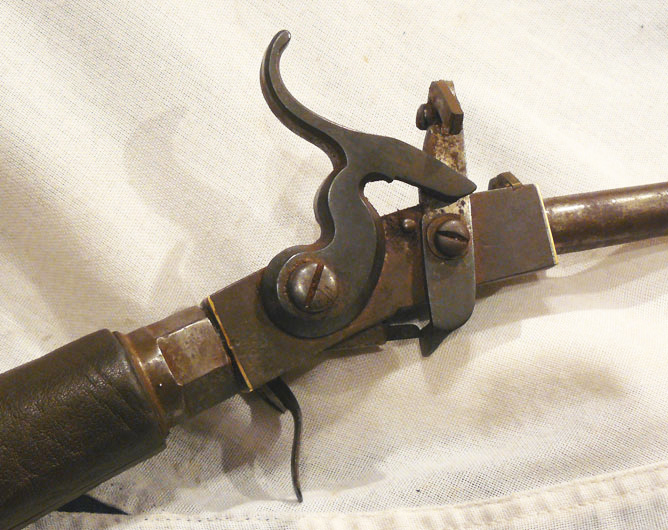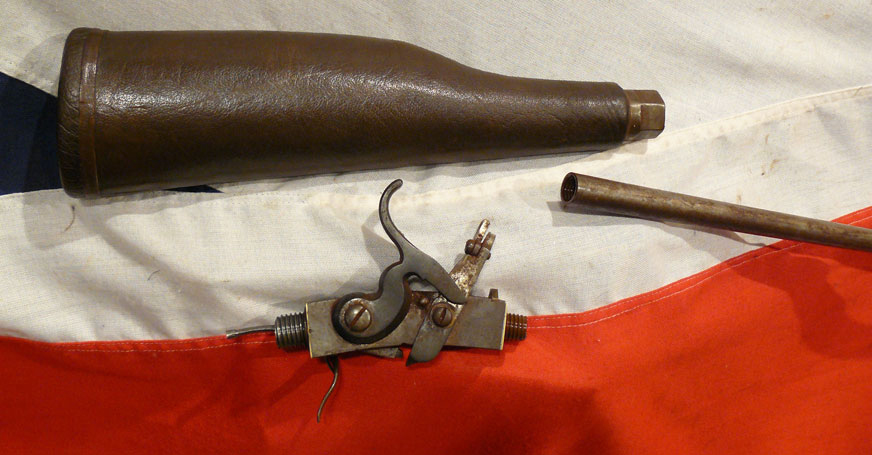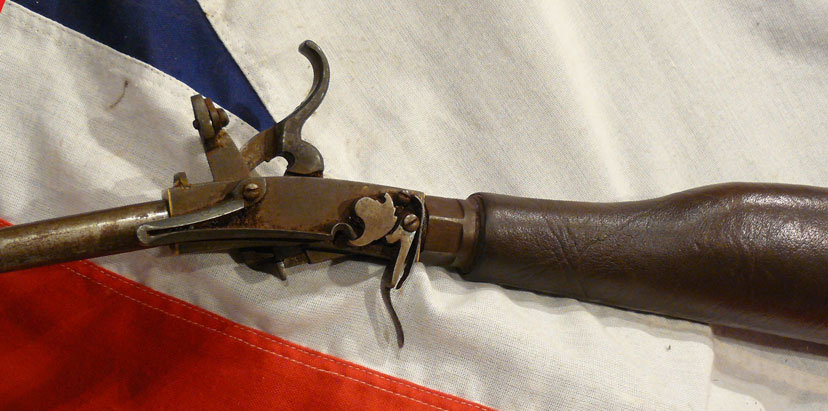18th Century, Very, Very Rare Butt Reservoir Air-Gun, Outside Lock, Circa 1785. Very Few People Realise Just How Far the Air Rifle Can Trace Back It’s History. And, Just How Amazingly Effective They Were
Likely German. Recently returned from being featured in a documentary on the Lewis and Clark Expedition. We have only had two such similar reservoir butt guns in the past 20 years. Fine resevoir guns such as this were made by Samuel Henry Staudenmayer around 1799, he was a former workman of John Manton, gunmaker to the Prince of Wales and the Duke of York. Two air weapons by this maker are recorded in the Hanoverian Royal Gunroom, one of which was sold at Sotheby's, Hanover, October 2005. He is also the maker of a Girandoni-system air rifle that resides in the Royal Collection at Windsor (inv. No. L 409). Georg Wolf is recorded in Wurzburg circa 1775. Two bellow guns by this maker are preserved in the Bargello, Florence and another was formerly in the gunroom of the Princes zu Salm-Reifferscheidt-Dyck at Schloss Dyck. A Girandoni System Austrian Repeating Air Rifle, Circa 1795, was believed to have been taken on the Lewis & Clark Army Corps of Discovery Expedition in 1803-1806. The Girandoni air rifle was in service with the Austrian army from 1780 to around 1815. The advantages of an air gun were a high rate of fire, no smoke from propellants, and low muzzle report, these features granted it acceptance as a military arm. It did have its problems and was eventually removed from service for several reasons, but decades after introduction. While the detachable air reservoir was capable of around 30 continual shots it took nearly 1,500 strokes of a hand pump to fill those reservoirs. Later, an improvement of a wagon-mounted pump was provided. The reservoirs, were made from hammered sheet iron held together with rivets and sealed by brazing, and they proved very difficult to manufacture using the techniques of the period, and were always in short supply.
In addition, the weapon was very delicate and a small break in the reservoir could make it inoperable. Finally, it was very different from any other weapon of the time and any soldier using it needed to be highly trained.
The Lewis and Clark Expedition used the rifle in the demonstrations that they performed for nearly every Native American tribe they encountered on the expedition
As far back as 250BC, Pharaoh Ktesbias II of Egypt, first described the use of compressed air to propel a projectile. Modern air gun history began in the 15th century. These weapons were known as wind chambers and were designed using an air reservoir connected to a cannon barrel. These devices were capable of propelling a four pound lead ball over a distance of 500 yards, and able to penetrate 3 inch oak board. These weapons rivaled the power of gun powder based firearms of that time and came into use in the Napoleonic wars in the late 18th and early 19th centuries. Due to the fact that high powered air guns were both silent and deadly, they were feared by many, Nobility tried to keep these air guns out of the hands of commoners, and air resevoir butt guns even saw much combat in battle, including the Austrian Army that used an air resevoir rifle designed by Grandoni in 1779 that shot 20 rounds of .44 cal. bullets at speeds as high as 1,000 feet per second. They fought well against Napoleon's Army and even though the Austrian Army was outnumbered and lost the battle, the Austrian's armed with air guns demoralized Napoleon's Army, and they suffered had a great number of casualties. Air guns were so feared by Napoleon's Army that any enemy soldier captured with a air rifle was executed as an assassin. One important reason Napoleon was so fearful about air guns was because there was no cloud of smoke upon firing which would allow the sniper to be pin-pointed and killed.
One of the most famous air guns in history is the .36 caliber air gun that Lewis and Clark took along with them on their expedition of 1803-06 see painting in the gallery. They took it along for hunting, just in case the black powder got wet and also used it to impress the Indians, the Indians call this air rifle, "The smokeless thunder stick.". In overall fine condition. The round, smoothbore, appox .44 calibre, sighted, steel barrel, has smooth untouched surfaces, fine bore with front site.. Exposed cocking "hammer" with an external mechanism and sculpted mainspring: matching, smooth, blued surfaces and in functional order. Complete with its original air release lever. Leather wrapped, conical, hollow, steel butt stock/air reservoir. Matching mechanism with all of its original components, a strong mainspring and air release valve. Very fine stock. A very nice and complete example of a rare late 18th century German or Austrian Reservoir-Butt gun. Overall length, 55". As with all our antique guns no license is required as they are all unrestricted antique collectables
Code: 20919
3525.00 GBP









